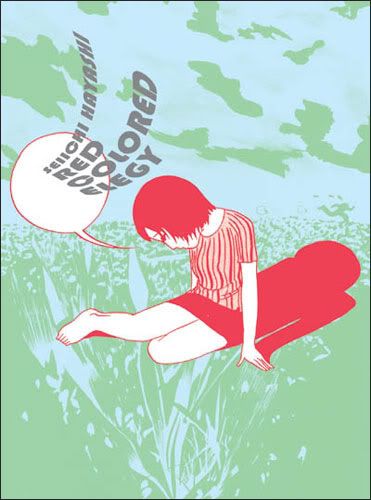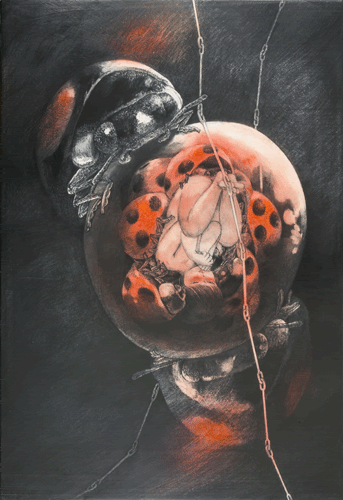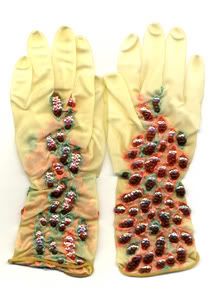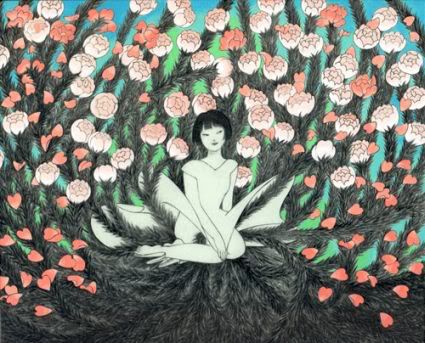 NEW YORK, April 21 – This is the second part of the transcript for the artist discussion with mangaka Kondah Akino (近藤聡乃).
NEW YORK, April 21 – This is the second part of the transcript for the artist discussion with mangaka Kondah Akino (近藤聡乃). TRANSCRIPT, PART 1 | PART 2
Ryan Holmberg: [Referring to Rainy Day Blues] This is one of the works appearing the English AX anthology. Sometimes your relationships between object and spaces are so horrific. Especially after 2003, they didn’t have this gothic or horror elements to them anymore. So often objects like umbrella and bracelets are lost and found again. It deals with memories. As your career develops, you still have this attachment to objects.
Kondah Akino: As I’ve said before, the beginnings of my stories are inspired by particular objects. In this case, it’s an umbrella. The depictions of horror and Gothic themes decreased in my work because my artistic tastes changed. Since I haven’t published frequently, there are a couple of years in between works. So, my work might appear to be very different between the current work and the preceding one.
RH: This is kind of annoying, now, forcing the amity towards Garo. Hayashi Seiichi, who is a very significant Garo (ガロ) artist, wrote the afterward to your first book. Hayashi is in the show and is most well known for his major Garo serial, Red Colored Elegy (赤色エレジー). More recently Red Colored Elegy was published by Montreal’s Drawn and Quarterly a couple of years ago. It’s on the reading table in the show. In addition to the afterward of your book, I believe he is always the judge for the AX amateur submissions. So, can you tell me about your relationship with Hayashi and his work?
KA: I first met Mr. Hayashi as an animation artist, not as a manga artist. I’ve been told by others that my artistic style resembles his, but I actually haven’t seen his work until that time.
RH: You know, I think the things that look a lot like Hayashi are those flowers in this negative space [referring to slides]. Even this book that this boy’s reading that drops into the gutter on the top. It looks like the cover to one of the edition to Sekishoku Erejii (Red Colored Elegy).

Red Colored Elegy by Seiichi Hayashi
KA: You might be talking about the other cover he did for Emino Kusako (sp?). A small sized novella.
RH: Emino Kusako is a Gothic Fiction writer. You said it was a cover for one of his pocket sized books. So you are interested in Emino Kusako?
KA: I was really more interested in Emino Kusako rather than Edogawa Rampo - Tarō Hirai (平井 太郎).
RH: I’ve brought some comparisons. Your work, Beautiful Town (美しい町)(2001), reminds me of Hayashi Seiichi’s Town of Falling Flowers (1968). Some of the pages have a very similar use of space. Also in some other scenes of a running child, there are certain sounds emanating outward.
KA: I heard that Mr. Hayashi was also told by someone else that his style resembles Ryoji, the painter. Mr. Hayashi was also telling me that he had rarely seen his work. [These common influences] comes from growing up in Japan and seeing similar things. We happen to share a common source of inspiration. We don’t really know …
RH: This is kind of an insider thing for people who know about Japanese pop culture, but your girl runs like Arale-chan (則巻アラレ) from Doctor Slump. (audience laughs)
KA: That’s possible.
RH: It’s possible? Another thing I want to discuss is your fascination with insects in your manga.
KA: I’ve always like insects since I was a child.
RH: What about them?
KA: The shapes and colors. I like to position them in between objects and humans.
RH: [Referring to Beautiful Town] There’s a lot of transformation and metamorphosis in your work. In this case, one girl is tricked by another into thinking that if she looks at ants closely they will turn into butterflies. It’s not really clear if this is actually true of not. Here you have her squatting down and focusing really closely at the ants. And all of a sudden they burst into butterflies. It seems like insects often times use the trope of metamorphosis.
KA: Maybe you’re right about that… [audience laughs]

“Ladybirds' Requiem” (てんとう虫のおとむらい) by Kondoh Akino
RH: [Referring to Lady Bug Funeral (てんとう虫のおとむらい)] I think this is one of your most famous scenes. I think a lot of people know this work. What is she wearing?
KA: It’s just a story about a girl who sews hundreds of buttons onto the back of her dress. When I realize that buttons resemble ladybugs, I decided to make this work. In this case, the buttons transform into ladybugs and bites the person.
RH: Have you made this dress?
KA: No.
RH: Is this completely fiction? Now, this is another work on your left [referring to Grave of the Butterflies]. You told me that you like Umezu Kazuo, the famous horror girl’s manga author from the 50s and 60s. Often times Kazuo has insects appearing in his work. The girl is usually inflicted by insects. In this case, the girl is traumatized by a butterfly shadow that she sees in her youth.
KA: I don’t know this particular work by him. Regarding Kazuo, I consider myself a fan, but I’m not really influenced by him. I don’t really see any of his influence in my art work.
RH: Your work has many different connections to horror fiction. Whether it is Umezu Kazuo, you do have different themes with it and backgrounds…
KA: When I was in Junior High School, I read novels by Kazuo almost every day. I know it had a tremendous influence on me…
RH: Here is another Umezo. You have a lot of pattern in your work, but you always hand draw it. Where traditionally a lot of manga artists use lattice patterns and screen tones. You always hand draw it.
KA: I just don’t like screen tones. That’s why I didn’t use them. I just don’t like cutting them and pasting them.
RH: So, now, shifting gears. You have also been active as a painter.
KA: Painting has not really been a major element in my body of work. I’ve only started oil painting recently. This particular work was done as a school assignment.
RH: While you were in art school, you were doing painting, illustration, and manga at the same time.
KA: When I was in university, I really didn’t do much painting. I did study design and practiced a lot of drawing.
RH: In the United States and some Japanese schools, there are more and more classes for making comics and sequential art. Were there any comic art programs when you attended Japanese art school?
KA: I believe Kyoto Seika University in Kyoto has a manga department, but the Tama Art University, where I received my BFA, doesn’t have any specific manga programs.
RH: Was it acceptable to draw manga while you were in art school?
KA: Manga was totally created on my own as any independent work.
RH: [Referring to Menstral Flowers] I’m just going to go through the paintings and make comments. So, I’ve already made comparisons which are already unacceptable. They will really annoy you. To me… Something about your paintings remind me of post-war manga and neo-traditional painting with the use of floral patterns derived from old nippas. The girl is positioned in a certain way that really makes me think of a notorious screen from 1980 by Kayama Matsuo. We’ll just keep going… Obviously there are other connections. Specifically art historical. You have been doing some that are slightly Japanese art history versions?
KA: If you say so…
RH: This is not a definite reworking of Japanese art history?
KA: Maybe so…

RH: [Referring to slides] This is your recent work from 2008. Your work seems to get more and more psychedelic and abstract. You also do some sculpture. You described one earlier. This seems related to your first comic about the girl who has a hand with tadpoles on it. This was supposed to be interactive sculpture.
KA: This work was about touch and texture. This was about the tactile feeling when you touch a slug.
RH: What are the slugs made of?
KA: Sequins.
RH: People are supposed to wear these?
KA: No. It’s very fragile so you can’t really wear it anymore.
RH: When was it made?
KA: 2002.
RH: Now, here are some sketches for your animation. You’ve made two finished [animated] works. You’re making a third now. We’re going to screen both of those.
[ANIMATION 1]
RH: When did you animate this?
KA: I did this in Junior Year [of art school].
RH: Was it a music video for a band?
KA: I first used the music without permission. A few years later, I officially obtained permission from the artists and remade the animation. Then, I became friend with the musician and writer, Tomohisa Hitoshi Ware.
RH: Is there anything you can say about the production process?
KA: I just drew so many drawings everyday in order to come up an image. Then I came up with a storyboard. Following the storyboard, I create large drawings and colored the animation.
RH: All hand drawn?
KA: Yes. The second animation required 15 drawing or images. Animation is a painstaking process. This work was also created while I was at university for my BFA exhibition. I didn’t like the finish, so I recreated it. The reworked version was finished in 2006.
RH: It received gallery distribution. Does the Asia Society owns the previous one or the next one?
KA: This one.
RH: This is not cell animation, right? You draw the figures and the backgrounds separately and put them together in the computer.
KA: It’s all done on paper. Then I sometimes cut them out and recompose them in Photoshop.
RH: So, I want to let people ask questions. Thank you very much. [applause]
Question 1: I was curious. Have you shown your work at any film festivals?
KA: I’ve never shown at any festivals. I’ve never been interested in that…
RH: Are you going to show your next animation at a film festival?
KA: No. I’m not finished with that one. So, it’s going to be a while. I’m actually wondering whether to show it in a festival setting or a gallery setting. Because if I show this in the gallery first, it would be difficult to go the other way. I still have to figure out how to sell and market it. The exhibition editions of my animations are priced very high. Regarding the animation that I’m working on now, I would like to mass produce it and make it more available. I would also like to make these available on the internet.
RH: You can see these on Youtube, right?
KA: [nods in agreement]
Question 2: When you start your films, do you have an outline? Because your work is multi-referential from a psychological stand-point, from an art historical stand-point, and in the sense of biology usage. I’m referring to insect imagery and mushroom imagery. Are you thinking about those issues and plot it out? All these reference and how you to put them in there?
KA: Regarding animation, I strictly follow my story board. I don’t really deviate from it.
Question 2: So it’s all structured out…
KA: The first work was made improvisationally. Are there any relationship between my storyboards and paintings? I actually became concerned myself that there is a gap in artistic style between my animation and storyboard. That’s because if the animation has too many details, it becomes too labor intensive. It would require you have to create thousands of frames. But I was shocked by the aesthetically low-quality of my animation, then I started doing paintings. I like to raise the artistic quality in my next animation.
Question 3: Growing up in Japan, have you read any shojo manga?
KA: Barely read any girl’s manga or comic books.
Question 3: Is it because you don’t like the style?
KA: It was mainly because it was not allowed in my household when I was growing up. That’s why I have brothers… [audience laughs]
RH: Is that how you read Garo when you were young through your brothers? It’s difficult to imagine you reading Garo when you were young.
KA: No. I actually never read Garo when I was young. I only start reading Garo in high school.

Question 4: Who is your primary audience for your animation?
KA: The first animation was shown on television in addition to the gallery. It had a wide audience. On the other hand, the second animation was only shown through galleries, so only people interested in contemporary art has seen it.
RH: You’ve shown your animation in shows in China, Singapore, and Europe.
KA: Yes, in Belgium and France.
RH: Museum shows?
KA: In the beginning, it was museums and festivals.
RH: Not film festivals.
KA: Not film festivals. The opportunities came about by themselves. I didn’t seek them. I was invited and went there to present my work.
[READ PART 1]


No comments:
Post a Comment